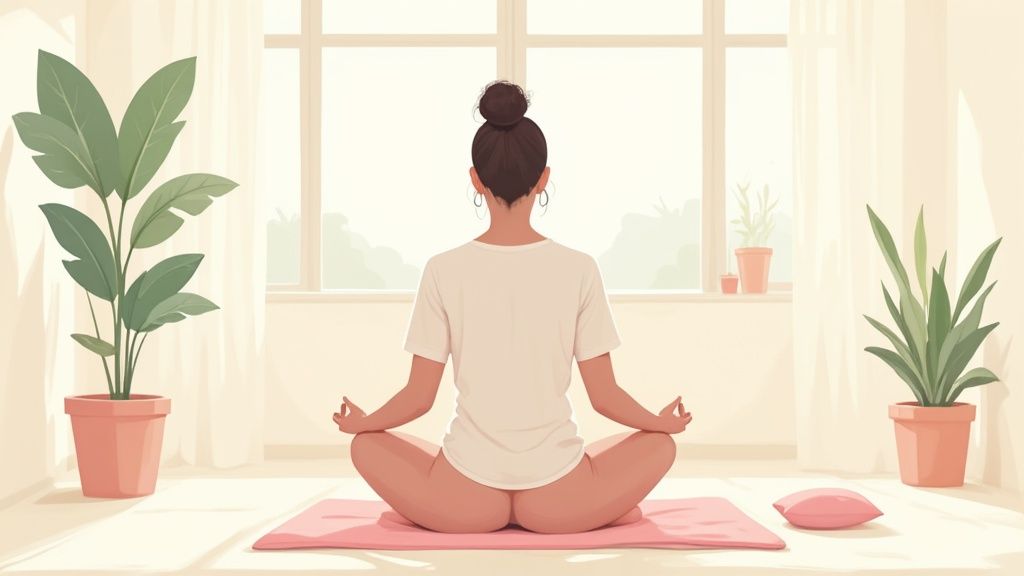Mindfulness Meditation for Beginners: A Simple Guide


The Essence of Mindfulness: Beyond the Myths

Mindfulness meditation is often misunderstood by beginners. Many people believe it requires a completely empty mind or long periods of perfect stillness. However, mindfulness simply means paying attention to the present moment without judgment. This involves observing your thoughts, feelings, and physical sensations as they occur, without letting them control you.
It's about acknowledging your internal experience without any self-criticism. For example, imagine feeling anxious. Instead of struggling against the anxiety, mindfulness encourages you to simply observe it. What physical sensations do you experience? What thoughts go through your mind?
By observing these experiences without judgment, you create a separation between yourself and your reactions. This allows you to respond more effectively. The accessibility of mindfulness also makes it attractive to people from all backgrounds.
Unlike some meditation practices that require specific spiritual beliefs or extensive training, mindfulness can be easily incorporated into everyday life. This simplicity is particularly helpful for beginners.
In recent years, mindfulness meditation has seen a surge in popularity, especially in the UK. By 2018, approximately 15% of British adults had learned to practice mindfulness, a significant increase compared to the 2.5% reported in the USA in 2012. This rise is largely due to its integration into various sectors, such as education and business. For a deeper dive into these statistics, you can find more detailed information here.
Debunking Common Mindfulness Myths
Several misconceptions often prevent people from exploring mindfulness meditation. Let's address some of the most prevalent myths:
Myth 1: You Need to Clear Your Mind: Mindfulness isn't about achieving an empty mind. It's about observing your thoughts without getting swept away by them. Visualize your mind as the sky and your thoughts as clouds passing through. You simply watch the clouds drift by without chasing after them.
Myth 2: You Need to Sit in Lotus Position for Hours: While some traditional meditation practices involve specific postures, mindfulness can be practiced in any comfortable position. Whether sitting, lying down, or even walking, the key is to maintain awareness of the present moment.
Myth 3: Mindfulness is a Religious Practice: While mindfulness has roots in Buddhist traditions, it is now a secular practice. It can benefit anyone, regardless of their beliefs. Mindfulness is simply a method of training your attention and developing awareness.
Understanding these core principles empowers beginners to approach mindfulness with a realistic and accessible mindset. It removes the pressure of striving for perfection and allows individuals to experience the many benefits of present moment awareness.
Surprising Benefits Even First-Time Meditators Experience

Building on a foundational understanding of mindfulness, let's explore the tangible benefits beginners can experience. You might be surprised at how quickly mindfulness meditation can positively impact your well-being, even after just a few sessions. This isn't just anecdotal; there's real science behind these changes.
Immediate Effects of Mindfulness Meditation for Beginners
From your very first mindfulness meditation session, you may notice a shift in your internal state. This is because mindfulness creates measurable changes in your brain and nervous system. One of the most immediate benefits is a sense of calm.
As you focus on your breath and observe your thoughts without judgment, you activate the parasympathetic nervous system, which is responsible for relaxation. This can lead to a noticeable reduction in racing thoughts and a slower heart rate.
Additionally, mindfulness helps cultivate present moment awareness. Instead of dwelling on the past or worrying about the future, you become more attuned to the here and now.
This heightened awareness can enhance your appreciation for simple pleasures and reduce feelings of being overwhelmed. For example, you might find yourself savoring the taste of your food or noticing the beauty of a sunset.
Long-Term Outcomes of Consistent Practice
While immediate benefits are encouraging, the real transformation occurs with consistent mindfulness meditation practice. Over time, mindfulness strengthens your ability to manage stress.
It empowers you to observe stressful thoughts and emotions without getting carried away by them, allowing you to respond more skillfully to challenging situations. This also leads to improved emotional regulation.
By becoming more aware of your emotional landscape, you can recognize and manage your feelings more effectively. This can be particularly helpful for those struggling with anxiety or emotional reactivity.
Furthermore, mindfulness can enhance focus and concentration. Regular practice trains your mind to stay present, improving your ability to concentrate on tasks and reduce distractions.
The following table summarizes some of the common benefits associated with mindfulness meditation, differentiating between short-term effects and the outcomes achieved through long-term, consistent practice.
To help illustrate the progression of benefits, we've compiled a table outlining what beginners might experience:
Common Benefits of Mindfulness Meditation
| Benefit Category | Short-term Effects | Long-term Outcomes |
|---|---|---|
| Stress Reduction | Noticeable calming effect; Slower heart rate | Improved ability to manage stress; More skillful responses to challenging situations |
| Emotional Regulation | Reduced racing thoughts | Increased awareness of emotional landscape; More effective emotional management |
| Focus & Concentration | Increased present moment awareness | Enhanced ability to concentrate; Reduction in distractions |
As you can see, the benefits of mindfulness meditation deepen over time, impacting not only your immediate state of mind but also developing valuable skills for navigating life's challenges.
Balancing Expectations and Reality
Mindfulness meditation offers significant benefits, but it’s important to balance enthusiasm with realistic expectations. It's not a quick fix for all your problems, but rather a skill developed through ongoing effort. Studies show mixed results, particularly during times of high stress.
For instance, during the COVID-19 pandemic, while 60% of mindfulness meditation users in Britain reported positive mental health effects, 24% reported negative effects. Those with children under 18 were more likely to experience negative effects, highlighting the importance of considering individual circumstances. Explore this topic further.
However, even with these mixed findings, the potential for positive change makes mindfulness meditation a valuable tool for improving overall well-being. By understanding both the immediate rewards and the need for consistent practice, you can begin your mindfulness journey with a grounded and optimistic outlook.
5 Beginner-Friendly Mindfulness Meditation Techniques You Can Start Today

Now that you understand the benefits of mindfulness meditation for beginners, let's explore some practical techniques you can implement immediately. These techniques require no special equipment or lots of free time—just a willingness to be present in the moment.
1. Breath Awareness Meditation
This foundational practice anchors your attention to your breath, making it readily available in mindfulness meditation. It cultivates present moment awareness by gently redirecting your focus back to your breath whenever your mind wanders.
- Step 1: Find a comfortable seated or lying down position.
- Step 2: Close your eyes gently and turn your attention to your breath. Notice the sensation of the air entering and leaving your nostrils, or the rise and fall of your abdomen.
- Step 3: Your mind will inevitably wander. When you notice this, gently and without judgment, guide your attention back to your breath.
This continuous redirection strengthens your ability to focus and cultivates a sense of calm.
2. Body Scan Meditation
The body scan connects you to your physical sensations, promoting greater self-awareness and relaxation. It involves systematically bringing your attention to different parts of your body, observing any sensations without judgment.
- Step 1: Begin by lying down comfortably and closing your eyes.
- Step 2: Start with your toes and progressively move your attention up your body, noticing any sensations—tingling, warmth, tension, or even numbness.
- Step 3: Acknowledge each sensation without trying to change it, simply observing it with curiosity.
This practice can reveal areas of tension you may not have been aware of, promoting relaxation and reducing stress.
3. Mindful Walking
Mindful walking offers an active approach to mindfulness meditation for beginners who struggle with stillness. It involves paying close attention to the physical sensations of walking, anchoring you to the present moment.
- Step 1: Find a space where you can walk back and forth undisturbed.
- Step 2: Begin walking at a natural pace, focusing your attention on the sensation of your feet making contact with the ground.
- Step 3: Notice the movement of your body, the swing of your arms, and the rhythm of your breath as you walk.
Mindful walking can be surprisingly grounding, bringing a sense of presence to everyday activities.
4. The STOP Technique
The STOP technique provides a quick and effective way to defuse stressful moments. It's a simple acronym that can be used anytime, anywhere, to bring you back to the present.
- S: Stop what you are doing.
- T: Take a few deep breaths.
- O: Observe your thoughts, feelings, and body sensations.
- P: Proceed with awareness.
This tool is especially helpful for beginners in managing overwhelming emotions and reactions.
5. Gratitude Meditation
Gratitude meditation cultivates a positive mindset by focusing on what you appreciate in your life. This practice can shift your perspective away from negativity and enhance overall well-being.
- Step 1: Find a quiet space and sit or lie down comfortably.
- Step 2: Close your eyes and bring to mind something you are grateful for. It could be a person, a place, an experience, or even a simple pleasure.
- Step 3: Reflect on this source of gratitude, savoring the positive feelings it evokes.
This practice helps to foster a sense of contentment and appreciation, contributing to a more positive outlook.
These five techniques offer a practical starting point for your mindfulness meditation journey. Remember to start small, be patient with yourself, and enjoy the process of cultivating present moment awareness.
Building Your Practice: From Minutes to Momentum

Turning mindfulness meditation from a sporadic activity into a regular habit is a crucial step for beginners. This consistency is where the real benefits begin to emerge. This section provides practical strategies for creating a sustainable meditation practice that integrates smoothly into your everyday life.
Starting Small: The Power of 5 Minutes
Many beginners stumble by trying to meditate for too long at the outset. Beginning with just 5 minutes of mindfulness meditation is much more effective than aiming for longer durations and quickly abandoning the practice due to perceived difficulty. This shorter timeframe is less daunting and much easier to incorporate into a busy schedule.
Moreover, completing these short sessions fosters a feeling of accomplishment, encouraging you to continue. You can gradually lengthen your meditation periods as you become more comfortable and confident.
Creating a Consistent Routine: Anchoring Your Practice
Consistency is paramount when establishing any new habit, and mindfulness meditation is no exception. Choosing a specific time each day and adhering to it can significantly increase your chances of success. This dedicated time could be first thing in the morning, during your lunch break, or just before bed.
Experiment to discover what works best for your individual energy levels and daily schedule. Connecting your mindfulness meditation practice with an existing habit is another effective technique. For example, you might meditate right after brushing your teeth or just before your first cup of coffee. This establishes an environmental trigger that serves as a helpful reminder.
Using Apps Mindfully: Enhancing, Not Distracting
A variety of apps can support your mindfulness meditation journey. These apps frequently offer guided meditations, timers, and progress trackers, which provide helpful structure and encouragement, particularly for those just starting out. However, it's essential to utilize these tools mindfully.
Choose an app that aligns with your specific needs and resist the urge to constantly switch between different apps, as this can easily become a distraction.
Cultivating the Right Mindset: Self-Compassion and Realistic Expectations
A supportive mindset is fundamental for building a sustainable practice. Recognize that a wandering mind is a normal part of mindfulness meditation, not a sign of failure. When your mind inevitably wanders, simply gently redirect your attention back to your breath or your chosen point of focus.
Cultivating self-compassion is equally important. Don't criticize yourself if you miss a session. Simply acknowledge the lapse and return to your practice the next day. This gentle approach is part of what makes mindfulness meditation accessible for beginners.
The rising popularity of mindfulness has contributed to its broader cultural and economic impact. For example, meditation apps like Calm generated nearly $2 million in their first year, highlighting the increasing demand for mindfulness resources. Even the UK Parliament has incorporated mindfulness, with hundreds of politicians undergoing training. This demonstrates the growing appreciation for mindfulness as a valuable tool for mental well-being and productivity. Discover more insights about mindfulness statistics.
Addressing Common Obstacles: Navigating Challenges
Several obstacles can arise when building a mindfulness meditation practice. Proactively addressing these challenges can help you stay on track.
- Schedule Conflicts: If your designated meditation time is interrupted, be adaptable. Find an alternative time or shorten your session. Even a few minutes of mindfulness meditation can be beneficial.
- Restlessness: If you feel restless during meditation, try incorporating gentle movement or stretching before you begin. Alternatively, consider experimenting with walking meditation.
- Motivation Fluctuations: Motivation naturally waxes and wanes. On days when you feel less motivated, remind yourself of the benefits you've already experienced. Connecting with a supportive community can also provide valuable encouragement and accountability. Mindfulness meditation for beginners is a journey, not a race. By starting small, maintaining consistency, and nurturing a supportive mindset, you can establish a sustainable practice that improves your overall well-being.
Overcoming the Meditation Hurdles No One Talks About
Beginning a mindfulness meditation practice can be exciting. However, many beginners encounter unforeseen challenges that can disrupt their progress. These are often the unspoken hurdles, the internal and external obstacles that can make mindfulness feel frustrating rather than fulfilling. This section addresses these common roadblocks, offering practical solutions to help you navigate your journey with greater ease.
The Mental Barriers: Taming the Wandering Mind
One of the biggest misconceptions about mindfulness meditation for beginners is the idea of a completely clear mind. This expectation sets many up for disappointment. Mind-wandering is a natural brain function. Instead of seeing it as a failure, view it as a chance to gently redirect your attention.
Imagine your thoughts as leaves floating down a stream. You don't need to stop the flow, but you can focus on one leaf at a time, observing its journey downstream. This analogy illustrates acknowledging thoughts without judgment and returning your focus to your breath.
Another common mental barrier is expecting immediate relaxation and tranquility. While mindfulness meditation can lead to these states, it's not always instantaneous. Some sessions may feel more challenging than others, and that's perfectly normal. The key is to approach each session with patience and self-compassion.
The Physical Challenges: Finding Comfort and Stillness
Physical discomfort can also hinder a beginner's practice. Finding a comfortable position is crucial. Experiment with different postures—sitting on a cushion, in a chair, or even lying down—to discover what works best for your body. Adjust your position as needed; you don't need to force yourself into a difficult posture to meditate effectively.
Restlessness is another common physical challenge. If you're fidgeting or feel the urge to move, try gentle stretching or movement before your session. This can release physical tension and prepare your body for stillness. For those who find it particularly difficult to sit still, mindful walking can be a helpful alternative. This involves focusing on the physical sensations of walking, bringing awareness to the present moment through movement.
To help you further, we've compiled a table outlining common challenges and solutions:
Introducing the "Mindfulness Meditation Challenges & Solutions" table. This comparison table presents common beginner challenges alongside practical solutions and adjustments to make mindfulness more accessible.
| Challenge | Why It Happens | Practical Solutions |
|---|---|---|
| Mind-Wandering | Natural brain function; trying to suppress thoughts often backfires | Acknowledge thoughts without judgment; gently redirect attention back to the breath; visualize thoughts as passing leaves |
| Expectation of Immediate Relaxation | Mindfulness is a practice, not a quick fix; initial sessions may not feel tranquil | Approach each session with patience and self-compassion; understand that relaxation deepens over time |
| Physical Discomfort | Unfamiliar posture; underlying tension in the body | Experiment with different positions (cushion, chair, lying down); adjust posture as needed during meditation |
| Restlessness | Difficulty sitting still; excess energy | Incorporate gentle stretching or movement before meditation; try mindful walking as an alternative |
Key takeaway: Addressing both mental and physical challenges is essential for a successful mindfulness practice. By understanding these common hurdles and implementing the suggested solutions, beginners can cultivate a more fulfilling and sustainable meditation experience.
Working Through Discomfort: Embracing the Process
Mindfulness meditation is a practice. Like any new skill, it takes time and patience to develop. There will be days when your mind races and your body aches. However, by understanding that these challenges are normal and temporary, you can move through them with greater ease and continue to reap the numerous benefits of mindfulness meditation.
Next Steps: Resources to Deepen Your Practice
This section offers a curated collection of resources for beginners looking to expand their mindfulness meditation practice. These selections are specifically chosen for their accessibility and suitability for newcomers.
Mindfulness Meditation Apps for Beginners
Several apps offer substantial free content, perfect for beginners exploring mindfulness meditation. These apps offer structured guidance, timed sessions, and progress tracking to help build a consistent practice.
Insight Timer: This app offers a vast library of free guided meditations from various teachers, covering diverse traditions and techniques. The extensive content allows you to experiment and discover what resonates best with you.
Smiling Mind: Specifically designed for beginners, Smiling Mind provides structured programs tailored to different age groups and needs. The user-friendly interface and short, guided meditations make it accessible and approachable for those new to the practice.
Books for Beginners
The following books are excellent resources for those new to mindfulness meditation, avoiding the complexity sometimes found in more advanced texts.
"Mindfulness for Beginners" by Jon Kabat-Zinn: This classic text provides a clear and accessible introduction to mindfulness. It includes step-by-step instructions for various mindfulness techniques, making it a great starting point.
"Wherever You Go, There You Are" by Jon Kabat-Zinn: This book delves into the essence of mindfulness in everyday life. It offers practical guidance on incorporating mindfulness into daily activities, helping beginners develop present moment awareness beyond formal meditation practice.
Online Communities
Connecting with a community can offer support and motivation on your mindfulness journey. These online groups provide safe and non-judgmental spaces to share experiences and learn from others.
- Mindful.org: This website hosts a vibrant online community where beginners can connect with experienced practitioners. Mindful.org’s forum offers a platform for asking questions, sharing insights, and finding encouragement.
Structured Learning: Courses and Groups
For those who prefer a more structured approach, consider these options:
Online Mindfulness Courses: Numerous platforms offer self-paced online mindfulness courses designed specifically for beginners. These courses provide a thorough introduction to mindfulness principles and techniques.
Local Meditation Groups: Joining a local meditation group provides the opportunity to practice mindfulness in a supportive environment. These groups often offer guided meditations, discussions, and opportunities for connection. Many centers also host introductory sessions perfect for beginners.
Navigating Your Personal Mindfulness Journey
Each meditation experience is unique, as is your individual mindfulness journey. While the resources listed above offer valuable tools, choosing those that align with your specific needs and preferences is key. Consider your learning style, personal goals, and budget when selecting resources. This personalized approach empowers you to create a sustainable and enriching practice.
Ready to deepen your coaching practice and personal growth? Explore Coaching Hub, a dynamic blog dedicated to empowering coaches and personal development enthusiasts. Discover actionable insights, proven techniques, and inspiring stories to enhance your coaching skills and personal journey.